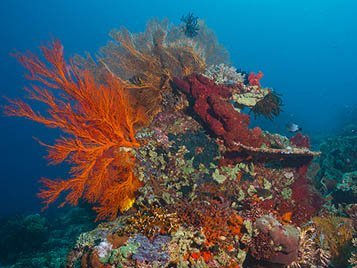DIVE SITE AT MENJANGAN ISLAND

Dive Site – Anker Wreck
No-one actually knows the origin of this small wooden boat, nor its true name … “Anker” comes from the anchor that still lies about 6-8m from the surface.
Starting the dive with the deepest point first, we follow the anchor chain down to where the steep, coral-clad slope becomes sandy (approx 30m). Here there is a second anchor and you begin to see the flattened remains of the wreck, dark against the white sand.
The rest lies strewn over an area of about 60m; going down to 50m. Across the site you will find copper sheeting and bottles, the boat’s cargo (artefacts, not for souvenirs). There are still some parts of the boat which remain out of the sand, and which are covered in gorgonians, a sure sign of little or no currents at the site.
On the sand we see many varieties of nudibranchs, sometimes frogfish and odd sand-dwellers. Schooling around the pieces of wreck are bannerfish, fusiliers and batfish.
This is the deepest dive site offered by AquaMarine Diving – Bali: We believe that the good visibility and calm conditions mean that this deep dive will present no problems to experienced divers.
The wall to the west, at 5-10m, is rich with many overhangs, cracks and caves. A good idea for an extended safety stop after this dive.
Dive Site – Garden Eel Point
Starting this dive from the most north west tip of Menjangan Island, following the wall southwards towards the Bali/Menjangan channel, you will see some of the most healthy and diverse coral on Menjangan. The cracks and breaks in the wall are filled with a great diversity of reef fish.
Gradually following the wall down from the top (5-8m) to 25m (max depth 35m), where it becomes a white sand slope, you find a big gorgonian fan with Longnose hawkfish.
What you will see at Garden Eel Point This area is also known for sightings of White-tip and Black-tip reef sharks, Dogtooth tuna, small schools of barracudas, turtles, and of course Napoleon wrasse. From this 25m point we slowly ascend up the slope, over many soft corals, until reaching a huge colony of Garden eels that covers the slope from 20m to beyond where it flattens out at 14m.
From Garden Eel Point we head south to a coral garden (5-12m) with Big-eyed trevally, Titan triggerfish, many clownfish in their anemones and often a surprising number of scorpionfish. Make sure you check the numerous sea fans for any of the variety of Pygmy seahorses we see here.


Dive Site – Pos II
Located on Menjangan’s most south easterly point, Pos II can be beach-entry or boat-entry, and is usually a gentle drift dive: whether beach or boat, the dives start at 12m where the white sand slope meets the top of the wall.
If there is a current, it is generally north easterly. Slowly descending along the wall, drifting with the current to approximately 25m, we see a profusion of soft corals, sponges, small gorgonians, moray eels and lionfish. As we level out, the current takes us along the wall to the east point of the island, a dramatic area covered in large gorgonians.
Here, where we meet the waters travelling down the north east of Menjangan, there is an upwelling of cold waters (ie: thermoclines) from the deep ocean. This sometimes brings with it turtles, Manta rays, sharks, an occasional Mola-Mola and other pelagics.
Our safety stop is done above the reef flats and as there is quite a population of Titan triggerfish in the area, we need to choose our spot carefully.
Very occasionally we find that the current is actually heading west. This takes us almost immediately to an area where, if the conditions are right, you can see pelagics. Descending slowly along the wall, you will see angelfish, anthias, chromis, gobies, scorpionfish. The surface of the wall is full of crevasses, cracks and overhangs which hide many treasures. There is the occasional cave too.
